10 solving quadratic equations
- 格式:docx
- 大小:32.67 KB
- 文档页数:11
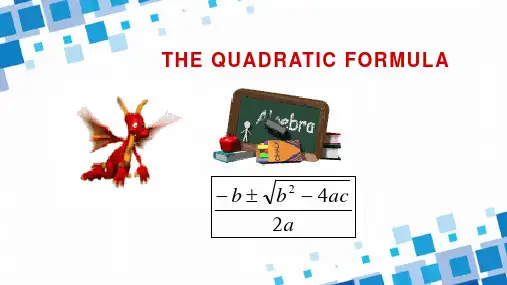
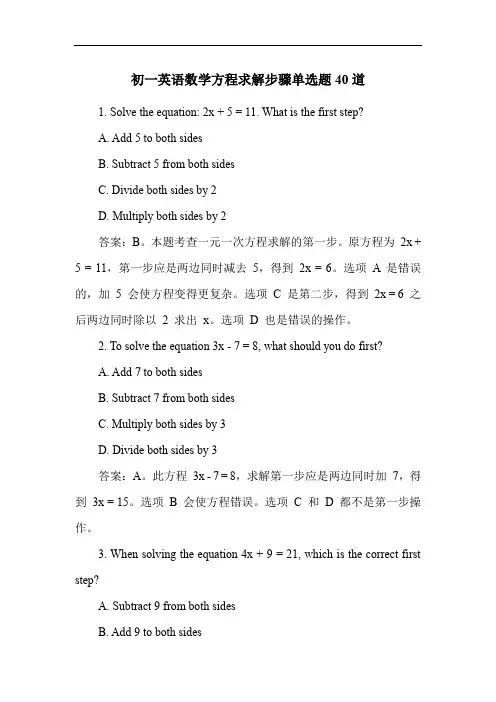
初一英语数学方程求解步骤单选题40道1. Solve the equation: 2x + 5 = 11. What is the first step?A. Add 5 to both sidesB. Subtract 5 from both sidesC. Divide both sides by 2D. Multiply both sides by 2答案:B。
本题考查一元一次方程求解的第一步。
原方程为2x + 5 = 11,第一步应是两边同时减去5,得到2x = 6。
选项A 是错误的,加5 会使方程变得更复杂。
选项C 是第二步,得到2x = 6 之后两边同时除以2 求出x。
选项D 也是错误的操作。
2. To solve the equation 3x - 7 = 8, what should you do first?A. Add 7 to both sidesB. Subtract 7 from both sidesC. Multiply both sides by 3D. Divide both sides by 3答案:A。
此方程3x - 7 = 8,求解第一步应是两边同时加7,得到3x = 15。
选项B 会使方程错误。
选项C 和D 都不是第一步操作。
3. When solving the equation 4x + 9 = 21, which is the correct first step?A. Subtract 9 from both sidesB. Add 9 to both sidesC. Divide both sides by 4D. Multiply both sides by 4答案:A。
对于方程4x + 9 = 21,首先应两边同时减去9,得到4x = 12。
选项B 操作错误。
选项C 是第二步。
选项D 不是正确的第一步。
4. Solve: 5x - 12 = 18. What is the initial step?A. Add 12 to both sidesB. Subtract 12 from both sidesC. Multiply both sides by 5D. Divide both sides by 5答案:A。
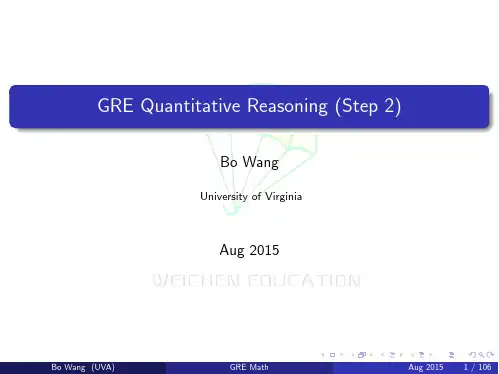
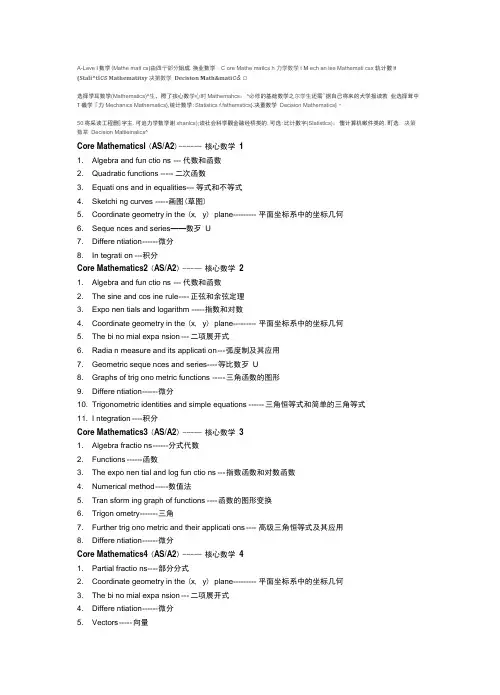
A-Leve l数学(Mathe matl cs)由四亍郃分姐成.换业数学・C ore Mathe matlcs h 力学数学t M ech an les Mathemati csx 轨计數H (Stali^tl cs Mathematitsy 决第數学Decision M ath&mati c& □选择学耳数学(Mathematics)^生,際了孩心数学心时Mathemahcs:^必修的基础数学之尔学生还需^据自己将来的犬学报读若业选择茸中T磯学『力Mechanics Mathematics},统计数学:Statistics f.fathemstics}.决董数学Decision Mathematics]・50将采读工程删]字主.可追力学数学谢xhanlcs);读社会科学觀金融经桥类的.可选:比计數字(Slatistlcs):僂计算机嗽件类的.町选: 决策数韋Decision Maltieinalics^Core Mathematicsl (AS/A2) ------ 核心数学11. Algebra and fun ctio ns --- 代数和函数2. Quadratic functions ----- 二次函数3. Equati ons and in equalities --- 等式和不等式4. Sketchi ng curves ----- 画图(草图)5. Coordinate geometry in the (x, y) plane--------- 平面坐标系中的坐标几何6. Seque nces and series——数歹U7. Differe ntiation ------ 微分8. In tegrati on --- 积分Core Mathematics2 (AS/A2) ----- 核心数学21. Algebra and fun ctio ns --- 代数和函数2. The sine and cos ine rule ---- 正弦和余弦定理3. Expo nen tials and logarithm ----- 指数和对数4. Coordinate geometry in the (x, y) plane--------- 平面坐标系中的坐标几何5. The bi no mial expa nsion --- 二项展开式6. Radia n measure and its applicati on --- 弧度制及其应用7. Geometric seque nces and series ---- 等比数歹U8. Graphs of trig ono metric functions ----- 三角函数的图形9. Differe ntiation ------ 微分10. Trigonometric identities and simple equations ------ 三角恒等式和简单的三角等式11. I ntegration ---- 积分Core Mathematics3 (AS/A2) ----- 核心数学31. Algebra fractio ns ------ 分式代数2. Functions ------ 函数3. The expo nen tial and log fun ctio ns --- 指数函数和对数函数4. Numerical method ----- 数值法5. Tran sform ing graph of functions ---- 函数的图形变换6. Trigon ometry ------- 三角7. Further trig ono metric and their applicati ons ---- 高级三角恒等式及其应用8. Differe ntiation ------ 微分Core Mathematics4 (AS/A2) ----- 核心数学41. Partial fractio ns ---- 部分分式2. Coordinate geometry in the (x, y) plane--------- 平面坐标系中的坐标几何3. The bi no mial expa nsion --- 二项展开式4. Differe ntiation ------ 微分5. Vectors ----- 向量6. In tegrati on --- 积分A-Level :核心数学 Core Maths ,力学数学,统计数学,决策数学 1 2 3 4 5 6 7oio14 14 1520 24 252b3S丽48b4Core Mathematics1 (AS/A2 ) ----- 核心数学 1 8. In tegrati on ------ 积分 每章内容:SketclSketching < \4.1 4.2 4.3 4.44.5Quadratic functions 2A2.2 2.3 2.4 2.5 2.6 1 Algebra and futictlons1.1 1.2 L3 1用 IS L6 L7 L8 Summary of key poinisPlotting the s^phs of Solvingquadratic eqi 】“ 沪 巧 Completingthe: Solving quddratiuSolving quadrate t ions by “Sketching Z> JSummary of kfy 尸為Equations 匚 M Solving sinSolving simultaneob.Using substISolving linGi 『 in 何亦It 華& Solving quadratic^^^ii^sj.jtions by elimination 屈tion* by substitutinn f equation Is linear and the other is quadraticSimplifying an expression by collecting like termsThe laws Qf indicesExpanding an expression Factorhing an expressionFactorising a quadr^k expressionThv las\s of indices for dll rational exponents The use and nianipulation of it rdsRationalising the iknonnridtor of a fraction ivhen 才二dw: XCxsE by ractor i sa ti映>;肯『 c equtijLArby comgTfctjng th 」square .' 'J u iht^m uh Quadratic formulae ; ^ncc^is liiKar rq 3.13.2 33 3J 3.5Suiiunary of 匕叮心疋试he 护ph$ of cubic functions Interpr^lW^yaphs nf cubk fuiKtioiuSketch inutile reciprocal function JK ■ttivinicr sect ion points of o[ functions to solv< equations of the triinsfbr mat ions f(x + ⑷ dnd 冃工-川 舉effect of the transforiiiations fiux) and'Fftrfotming transformations on the sketches of curves詁ry of key pointsAlgebra and fun ctio ns ----- 代数和函数 Quadratic functions ----- 二次函数Equati ons and in equalities --- 等式和不等式 Sketchi ng curves --- 画图(草图)Coordinate geometry in the (x , y ) plane -------- 平面坐标系中的坐标几何 Seque nces and series ——数列Differe ntiation ------ 微分5 Coordinate geonwtry in the (x9 y) plane 6S5.1 The equation of a straight line in the form y = nix + c or ax + 如 + c = 0 655.2 The gradient of a straight line 605.3 The equation of a straight line of the form y - y严ifi(x - 心) 7&5.4 The formula for finding the equation of a straight line5.5 The conditions for two straight lines to be parallel or perpendicular ' 75Summary of key points6 Sequences and series6.1 Introduction to sequences6.2 The nth term of a sequence 0 836.3 Sequences generated by a recurrence relationship i \ // ()856.4 Arithmetic sequences 二886.5 Arithmetic series \C/^ \ °°6.6 The sum to n of an arithmetic series 936.7 Using X notation 」97Summary of key points ' 〃丿) 101 7 Differentiation (//. 1027」The derivative of f(x) as the thiCpn^kto tft^ graph y = f(x) 102105109113114115116117121122122124125126128130Core Mathematics2 (AS/A2 ) 核心数学 21. Algebra and fun ctio ns ---- 代数和函数2. The sine and cos ine rule ---- 正弦和余弦定理3. Expo nen tials and logarithm ---- 指数和对数4. Coordinate geometry in the (x , y ) plane -------- 平面坐标系中的坐标几何5. The bi no mial expa nsion --- 二项展开式6. Radia n measure and its applicati on --- 弧度制及其应用7. Geometric seque nces and series --- 等比数歹 U8. Graphs of trig ono metric functions ---- 三角函数的图形9. Differe ntiation ------ 微分 10. Trigonometric identities and simple equations ------ 三角恒等式和简单的三角等式 11. I ntegration ---- 积分 每章内容: Aigcbrj dEid luiKtions 1J1.2 13 1.4 Simplifying algebraic fractions by division Dividing apolynomial by (x i p)Factorising a polynomial using the Factor TheoremUsing the Remainder Theorem Summary of k (?y pointsThe sint : and cosine ruleUsing the sine rule to find missing sides Using the sine nde find unF^wn angles The rule andfinding two w* Using the cosine ruEc ia Fin# Using the cosine rule tc a Using the sine tl «Calculaikng the area 2A 2.2 23 2.4 2.5 2.6 2.7 f or a nih^F Eo切 Mck ssing an^ic^ L . ■ #4RI le 3 nr< !'『 庶耳竝遁 Theo re mot^Jy^ngle us)闵jExponctuiah an<r^ogaMh * 3J王2 玉33.43.5 3.6Summary of key pointsCk Coordinate in the (x, y\ plant4.1 The 4.2 The ciiibi Suniinjjy of key polrt 115 10 131718 18 21 23 24 27 30 32 36 37 37 39 4() 41 43 45 4ti 49 49 57 60 68 70 70 72 73 75 79tnsTh<bfunctk 严 Writing ns as a Calculating *丄耳 to Laws of JogarithmS Solvi ng equations 汐 a' - b Changing the mt ni ot A line M 峥曲亡two points on a line 4*3 The equatitJiiif a circle Summiiry of fr r/ points iriomTal expansion s triangle X Combinntions and factorialUsing (:) m the binomial expansion5-4 Expanding (d + bxY r using the binomial expansion Summary of key point*11o Kaaian measure ana its applications Using radians to measure angles The length ofthe arc of a circle The area of a sector of a circle The area of a segment of a circle Geometric sequences Geometric progressions and the nth term Usinggeometric sequences to solve problems The sum of a geometric seriesThe sum to infinity of a geometric series Graphs of trigonometric functionsSine, cosine andtangent(unctionsThe values of trigonomef/ functions in the Exact values and surds f Graphs of sine 0f cos J J 、 Simple transformants oDifferentiation9.1 Increasing s ・9.2 Stationarymaximun 、, minipjum and points of inflexion 9.3Using f^rninjf points to Summar 1 “ 亠 inisTrigonom^/ Jidentitie】0.161 6.2 6.3 6.4Summary of key pointsGeometric sequences and series 7.1 7.2 7.3 7.4 7.5Summary of key points8.1 8.2 8.3 8.4 &5Summary of key poE ;' le equations titles ometrical equations e formsin(nd + a), cos(n0 + a) and tan(n0 + a) = k ig?nometrical equationsSimple trigoSolving simj SolvingeqySolving qudIntegratio11.1 11.2 11.3 Are n.4 94 94 9598 100 103 109 110 110 114 117 118 121 127 141 141 146 149 151 156157 157 159 161 164 169 17710129 129 131135 1406 93 ms10.210.310.4Summary ote integrationa curvea curve that gives negative values n a straight line and a curve rapezium Rule of key points11Core Mathematics3 (AS/A2 ) 核心数学 31 2 3 4 5 6 7 8101Ki.S1 12每章内容:7.5 i'hc racloi tbrinuiai'Alxvbrdit Iriiciions1.1 1.2 1.3I'rigonomctry64 6.2AjipJying a corn^ixiatj Sketching trar^8 Differentiation8.1 B.2 8.3 K 4 8.58.68.71281301311322 E r unctioi-i^2,1 2.2 2-3 2.4 2.5Differentiating ti&ing the chain rule Differ ent tatlng using the product rult Differs nt latL ng using the quotient rukr I if fere nt iat j ng the exponential function Finding the differential of the logarithmic function. _Differentiating 5in x(C~Di fferenti ati ng cos xDifferent is tin^ t^n xDifferenliatkng further trigonometrLcaJ functions[differentiating functians formed by combining frigon 九丁贰#乎卜 cxprtncniiaL logfkritl-imLc and polynomial fLinctior^ ;Simplify algebraic fractions by LUI 1{.C IL UI ^ 口 Multiply dix jdici^frjLiujii->Adding and subtracting algvbrd k frautionsI nx alxvbriiit fr*ittic.jri^ jind tiir rcn )i»iii<lvr Ltit.-c.i^int <ln y 4-cn U>iTi 耳$ [JCX JJ€»TLOkl t k J I fLIIlC'Floriiir^^of <> gr^jj^/ica11 y 「_ ___2 =」cth^Js^lcrlind approximate root 萤 of 陶仟彳Tran 露Fermi 订呂 graf^/of fui^ctiini^5-1 Sketch! tig graphs ot 1^hhockx!^^ 4^u net ion y 一 lf(x)l 5u2 Sketching g^r^phs y = f(lxl) (A p olvin^a mcxluliis mictions to sketch erv«?« 什fih 订花JJ CFIM H 11 台 Mlielling lhe co-ordinates ofgiven H, cosecant 仇 and cotaingEfU 丹 f ^tant 也 cosecant 优 and cotangent 甘 xpressicmsj proving iclentiti^ iind solving equations, usingMapping diingrarns and 耳of opaeiiitions ( JFunc-tions <irid functioii notatk>tiRange, mapping diagrams,, graphs and definitionsJUsing composite functions #*f 丿Finding and using inverse-The exponential and log f u net ion s°3/1 Introdticing exponent ial ・ rtions of lhe I'omCj^ . h 心 3・立 Graphs of exponential旷卞:」^ 前m 扌匸卩 存占;逆"二tlxfn 琴, 严U^irig 护 ^Eidinwu b©■—主亠二亠亠」一■■Numerical method? ” 4.1 Finding approx if 4.2 U^ing ilerati algebraic iiicthi l ^irs'lw^nnd approximate rt>ots The fijnr/Q?6?/I TieSimplifying £ sec 他 cowO?R and cot Hidcnlitles l 十 lan 2^ = $2H and 1 + cot-^ = cosec 2IJs.iriglmerse trigcinometricai Uinclions and their graphs7 ..Further tngimonietrk identities and theif applies HonsSt/LMrig addition trigoiionietrical lormulac二Using double an^lc trigoiiDmctrical farmulae7?T Solving equdtiom and proving Idcntltiics using doubk iirigle foniiuLie ^^7 4 Usin^ the fonii a cos b sin B lin striving trigonotnetrical piobiennAlgebra fractions ------ 分式代数 Functions ----- 函数Transforming graph of functions -------函数的图形变换 Trigonometry ----- 三角Further trigonometric and their applications ------ 高级三角恒等式及其应用 Differentiation ------ 微分The exponential and log functions Numerical method ------ 数值法指数函数和对数函数Core Mathematics3 (AS/A2 ) 核心数学4Core Mathematics3 (AS/A2 ) 核心数学 51 2 3 4 556 vector37074 11B4 2110ft6J1111126139 SI6264 fi2 «2 AIXJUL L l||\ ULHJK2A3.2 33 Exam style paperFormulae you need to know List of symbols and notation AnswersIndexof two vectors n of a straightAdding and subtracting algehraic fractionsPartial fractions with two linear factors in the denominatorPartial fractions with ttnee or mor^ linear factors in th<? denominator Partial tract ions with repeated linear factors in the denominator Improper fractions into partial fractions1 Partial fractions L:y 1 ■jitrgrating £t^ndard Junctions Integrating using the reverse chain rule Using trigonometric identities in integrationUsing partial fractions to Integrate expressionsUsing standard patterns to integrdle expre^iorr liitvgraUon by subtjtiti.ition Integration by parts Numericalintegration Integration to find ateas and volumes 1Using integration to solvedifferential equations Difkrtntiai rquatjom in context2 Cootdinate geometry in the (x, y) 2」Parametric equations used toParametric equations used to dtiine the uxirdin^tes ot a Using paranictrkequ 訓 UKndinate 驴oimtr* Converting paramet^. jitions into cartesian 世qiut 档才 Finding the itrea ^iidche airve given by pannr 严旷 ^quations3 Fhe binomial ex3,i UMII^ VtXUMl IU UtSUilW J-^JJJLS I ;In 2 or 3 dimensions 二,二二 55Cartesian toniponeidi Gf a \yytor in 2dimensionsCartesian components ol in 3 dimensio%7^; Extending 2 /悸幺?冲results io ]he seal;| The vect*[nUT^clrnjfetraighi line vector 戸理逖石kFx linesJo between two straight Using partial fracti>#w$ Kjtw tiiv ■binamiai expanjy^f \、 Different la Uon4.1 Differentki(I nti ;ons givenpararnetricaifrf/4 2 Diffenyitiating^uationwhich arc implicitO43 Diffett»y^a!ing the function a 1 4.4{垃 tSftitiibn and rates of change4.5 唏蛙少他rtrntjai equations 5 VecS^ ?<^54,Ve?tor d^fmitipns 4nd vector ^^iiAgrams r 、§,2 Vector arithmetic and the unit vectorThe binomial expulsion a - positive integral index Using the binomidexpand + l^x)"\ j ' 6. In tegrati on ------ 积分 每章内容:The bi no mial expa nsion --- 二项展开式 Differe ntiation ------微分 Vectors ----- 向量Partial fractio ns ---- 部分分式 Coordin ate geometry in the ( x , y ) pla ne 平面坐标系中的坐标几何。
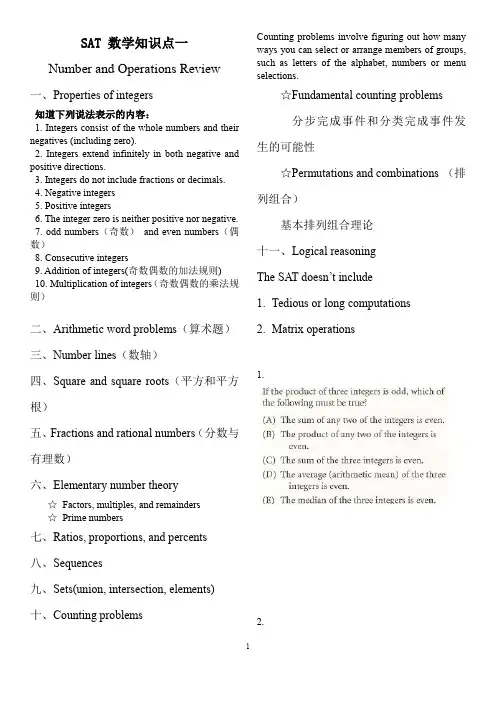
SAT 数学知识点一Number and Operations Review 一、Properties of integers知道下列说法表示的内容:1. Integers consist of the whole numbers and their negatives (including zero).2. Integers extend infinitely in both negative and positive directions.3. Integers do not include fractions or decimals.4. Negative integers5. Positive integers6. The integer zero is neither positive nor negative.7. odd numbers(奇数)and even numbers(偶数)8. Consecutive integers9. Addition of integers(奇数偶数的加法规则)10. Multiplication of integers(奇数偶数的乘法规则)二、Arithmetic word problems(算术题)三、Number lines(数轴)四、Square and square roots(平方和平方根)五、Fractions and rational numbers(分数与有理数)六、Elementary number theory☆Factors, multiples, and remainders☆Prime numbers七、Ratios, proportions, and percents八、Sequences九、Sets(union, intersection, elements)十、Counting problems Counting problems involve figuring out how many ways you can select or arrange members of groups, such as letters of the alphabet, numbers or menu selections.☆Fundamental counting problems分步完成事件和分类完成事件发生的可能性☆Permutations and combinations (排列组合)基本排列组合理论十一、Logical reasoningThe SAT doesn’t include1.Tedious or long computations2.Matrix operations1.2.3.4.5. 6.7.8.9.10.11.12.13. 14.SAT数学知识点二Algebra and Functions Review Many math questions require knowledge of algebra. This chapter gives you some further practice. You have to manipulate and solve a simple equation for an unknown, simplify and evaluate algebraic expressions, and use algebraic expressions, and use algebraic concepts in problem-solving situations.For the math questions covering algebra and functions content, you should be familiar with all of the following basic skills and topics:一、Operations on algebraic expressions二、Factoring三、Exponents四、Evaluating expressions with exponents and roots五、Solving equations☆Working with “unsolvable” equations☆Solving for one variable in terms of another☆Solving equations involving radical expressions六、Absolute value 七、Direct translation into mathematical expressions八、Inequalities九、Systems of linear equations and inequalities十、Solving quadratic equations by factoring 十一、Rational equations and inequalities 十二、Direct and inverse variation十三、Word problems十四、Functions☆Function notation and evaluation☆Domain and range☆Using new definitions☆Functions as models☆Linear functions: their equations and graphs☆Quadratic functions: their equations and graphs☆Qualitative behavior of graphs and functions☆Translations and their effects on graphsand functionsThe SAT doesn’t include:一、Solving quadratic equations thatrequire the use of the quadraticformula二、Complex numbers三、Logarithms1.2.3.4. 5.6.7.8.9.10.SAT 数学知识点三Geometry and Measurement Review Concept you should to knowFor the mathematics questions covering geometry and measurement concepts, you should be familiar with all of the following basic skills, topics, and formulas:一、Geometric notation二、Points and lines三、Angles in the plane四、Triangles(including special triangles)☆Equilateral triangles☆Isosceles triangles☆Right triangles and the Pythagorean theorem ☆30º-60º-90ºtriangles☆45º-45º-90ºtriangles☆3-4-5 triangles☆Congruent triangles☆Similar triangles☆The triangle inequality五、Quadrilaterals☆Parallelograms☆Rectangles☆Squares六、Areas and Perimeters☆Areas of squares and rectangles☆Perimeters of squares and rectangles☆Area of triangles☆Area of Parallelograms七、Other polygons☆Angles in a polygon☆Perimeter☆Area八、Circles☆Diameter☆Radius☆Arc☆Tangent to a circle☆Circumference☆Area九、Solid geometry☆Solid figures and volumes☆Surface area十、Geometric perception十一、Coordinate geometry☆Slopes, parallel lines, and perpendicular lines☆The midpoint formula☆The distance formula十二、TransformationsThe SAT doesn’t include:一、Formal geometric proofs二、Trigonometry三、Radian measure1.2.3.4.5.6. 7.8.9.SAT 数学知识点四Data Analysis, Statistics andProbability ReviewFor the math questions covering data analysis, statistics and probability concepts, you should be familiar with all of the following basic skills and topics:一、Data interpretation二、Statistics☆Arithmetic mean☆Median☆Mode☆Weighted average☆Average of algebraic expression☆Using average to find missing numbers三、Elementary probability四、Geometric probabilityThe SAT doesn’t include:四、Computation of standard deviation 1.2.3.4.5. 6.7.8.Word Problems1.2.3.4. 5-75.6.7.1112。
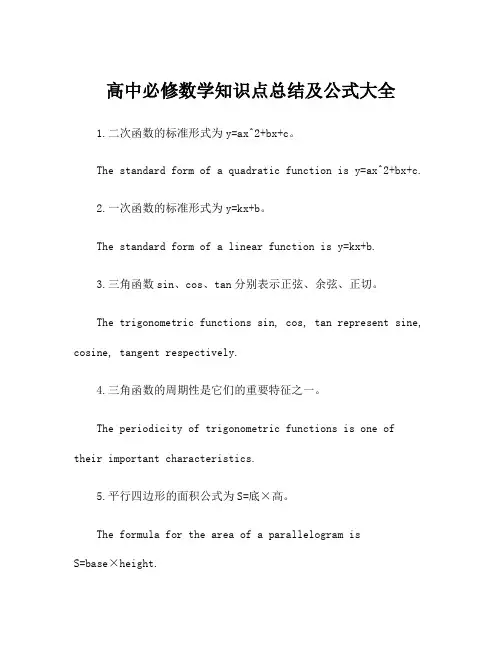
高中必修数学知识点总结及公式大全1.二次函数的标准形式为y=ax^2+bx+c。
The standard form of a quadratic function is y=ax^2+bx+c.2.一次函数的标准形式为y=kx+b。
The standard form of a linear function is y=kx+b.3.三角函数sin、cos、tan分别表示正弦、余弦、正切。
The trigonometric functions sin, cos, tan represent sine, cosine, tangent respectively.4.三角函数的周期性是它们的重要特征之一。
The periodicity of trigonometric functions is one oftheir important characteristics.5.平行四边形的面积公式为S=底×高。
The formula for the area of a parallelogram isS=base×height.6.直角三角形的勾股定理为a^2 + b^2 = c^2。
The Pythagorean theorem for a right-angled triangle isa^2 + b^2 = c^2.7.两点间距离公式为d=sqrt[(x2-x1)^2 + (y2-y1)^2]。
The distance formula between two points is d=sqrt[(x2-x1)^2 + (y2-y1)^2].8.二次方程的解法包括用公式法和配方法。
The methods for solving quadratic equations include using the formula and completing the square.9.函数奇偶性的判定方法是f(-x) = f(x)或f(-x) = -f(x)。
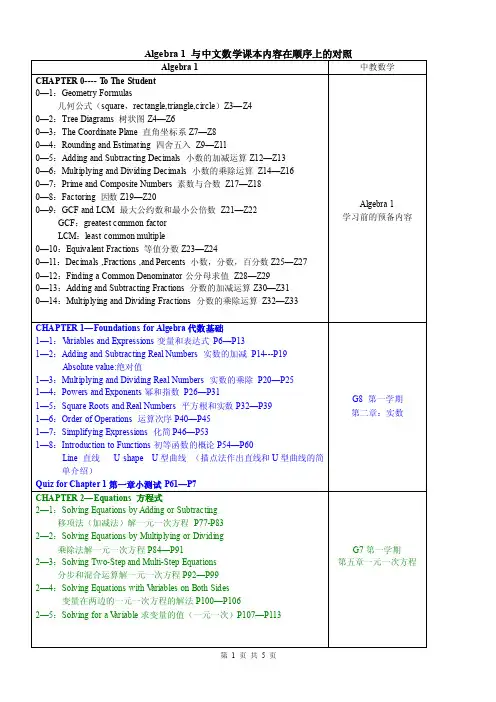
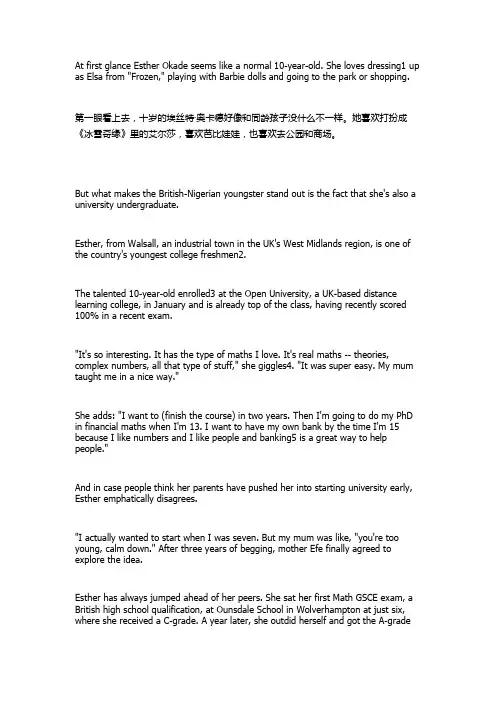
At first glance Esther Okade seems like a normal 10-year-old. She loves dressing1 up as Elsa from "Frozen," playing with Barbie dolls and going to the park or shopping.第一眼看上去,十岁的埃丝特·奥卡德好像和同龄孩子没什么不一样。
她喜欢打扮成《冰雪奇缘》里的艾尔莎,喜欢芭比娃娃,也喜欢去公园和商场。
But what makes the British-Nigerian youngster stand out is the fact that she's also a university undergraduate.Esther, from Walsall, an industrial town in the UK's West Midlands region, is one of the country's youngest college freshmen2.The talented 10-year-old enrolled3 at the Open University, a UK-based distance learning college, in January and is already top of the class, having recently scored 100% in a recent exam."It's so interesting. It has the type of maths I love. It's real maths -- theories, complex numbers, all that type of stuff," she giggles4. "It was super easy. My mum taught me in a nice way."She adds: "I want to (finish the course) in two years. Then I'm going to do my PhD in financial maths when I'm 13. I want to have my own bank by the time I'm 15 because I like numbers and I like people and banking5 is a great way to help people."And in case people think her parents have pushed her into starting university early, Esther emphatically disagrees."I actually wanted to start when I was seven. But my mum was like, "you're too young, calm down." After three years of begging, mother Efe finally agreed to explore the idea.Esther has always jumped ahead of her peers. She sat her first Math GSCE exam, a British high school qualification, at Ounsdale School in Wolverhampton at just six, where she received a C-grade. A year later, she outdid herself and got the A-gradeshe wanted. Then last year she scored a B-grade when she sat the Math A-level exam.Esther's mother noticed her daughter's flair6 for figures shortly after she began homeschooling her at the age of three. Initially7, Esther's parents had enrolled her in a private school but after a few short weeks, the pair began noticing changes in the usually-vibrant youngster.Efe says: "One day we were coming back home and she burst out in tears and she said 'I don't ever want to go back to that school -- they don't even let me talk!'"In theUK, you don't have to start school until you are five. Education is not compulsory8 until that age so I thought OK, we'll be doing little things at home until then. Maybe by the time she's five she will change her mind."Efe started by teaching basic number skills but Esther was miles ahead. By four, her natural aptitude9 for maths had seen the eager student move on to algebra10 and quadratic equations.And Esther isn't the only maths prodigy11 in the family. Her younger brother Isaiah, 6, will soon be sitting his first A-level exam in June.词汇表:1 dressingn.(食物)调料;包扎伤口的用品,敷料参考例句:Don't spend such a lot of time in dressing yourself.别花那么多时间来打扮自己。
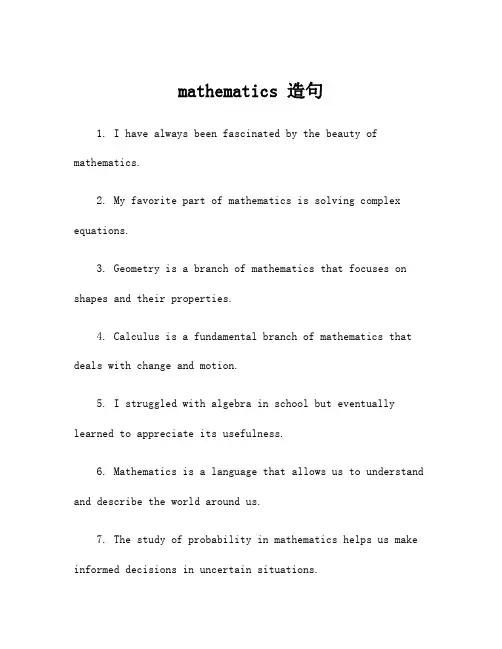
mathematics 造句1. I have always been fascinated by the beauty of mathematics.2. My favorite part of mathematics is solving complex equations.3. Geometry is a branch of mathematics that focuses on shapes and their properties.4. Calculus is a fundamental branch of mathematics that deals with change and motion.5. I struggled with algebra in school but eventually learned to appreciate its usefulness.6. Mathematics is a language that allows us to understand and describe the world around us.7. The study of probability in mathematics helps us make informed decisions in uncertain situations.8. The Pythagorean Theorem is a famous mathematical formula that relates the lengths of the sides of a right triangle.9. Mathematics plays a crucial role in computer programming and coding.10. Trigonometry is a branch of mathematics that deals with the relationships between angles and sides of triangles.11. I find joy and satisfaction in solving challenging mathematical puzzles.12. The study of number theory in mathematics focuses on the properties of whole numbers and their relationships.13. Statistics is a branch of mathematics that involves the collection, analysis, interpretation, and presentation of data.14. The discovery of calculus by Sir Isaac Newton and Gottfried Wilhelm Leibniz revolutionized the field of mathematics.15. The Fibonacci sequence, named after an Italian mathematician, is a series of numbers where each number is the sum of the two preceding ones.16. Algebraic equations are used to represent relationships between variables and are solved for unknown values.17. The concept of infinity in mathematics is both mind-boggling and fascinating.18. Mathematical proofs provide rigorous and logical evidence to support mathematical statements and theorems.19. The study of differential equations in mathematics is crucial in understanding how quantities change over time.20. The concept of symmetry is prevalent in mathematics, art, and nature.21. Mathematical modeling is the process of creating mathematical equations to describe and analyze real-world situations.22. The study of topology in mathematics focuses on the properties of space and how objects can be transformed.23. The distribution of prime numbers is an unsolved problem in mathematics.24. The concept of probability helps us assess the likelihood of events occurring in random experiments.25. Mathematicians use abstract algebra to study structures such as groups, rings, and fields.26. The study of combinatorics in mathematics involves counting, arranging, and selecting objects.27. The study of logic in mathematics helps us understand the principles of valid reasoning.28. The concept of limits and derivatives is fundamental in understanding calculus.29. Algebraic geometry is a branch of mathematics that combines algebraic techniques with geometry to study the properties of geometric objects.30. The mathematical concept of vectors is used to represent quantities that have both magnitude and direction.31. Trigonometric functions, such as sine, cosine, and tangent, are essential in solving problems involving angles and triangles.32. Bayesian statistics is a branch of statistics that incorporates prior knowledge and assumptions to make probabilistic inferences.33. The study of topology in mathematics involves analyzing the properties of space without considering distances or measurement.34. The concept of matrices is crucial in solving systems of linear equations.35. Discrete mathematics deals with objects that can only take on distinct and separate values, such as integers or graphs.36. The study of calculus helps us understand rates of change and the accumulation of quantities.37. The mathematical concept of symmetry is evident in the repeating patterns found in nature and art.38. The concept of infinity in mathematics is explored through subjects such as set theory and analysis.39. Applied mathematics uses mathematical methods to solve problems in various fields, such as physics, economics, and engineering.40. The mathematical concept of functions describes the relationship between inputs and outputs.41. Solving quadratic equations involves finding the values of x that satisfy the equation ax^2 + bx + c = 0.42. Linear programming is a mathematical technique used to optimize the allocation of limited resources to achieve the best possible outcome.43. The concept of imaginary numbers, represented by the square root of -1, is a fundamental part of complex analysis in mathematics.44. The field of cryptography relies on mathematical algorithms to secure information and protect communication.45. The mathematical study of chaos theory explores complex and unpredictable systems.46. Game theory, a branch of mathematics, analyzes strategic decision-making in competitive situations.47. The concept of symmetry transformations is important in the study of group theory in mathematics.48. The study of number theory involves exploring properties of prime numbers, divisibility, and number patterns.49. The concept of fractals, such as the Mandelbrot set, showcases intricate and self-repeating patterns in mathematics.50. The mathematical concept of limits is essential in understanding the behavior of functions as their inputs approach certain values.。
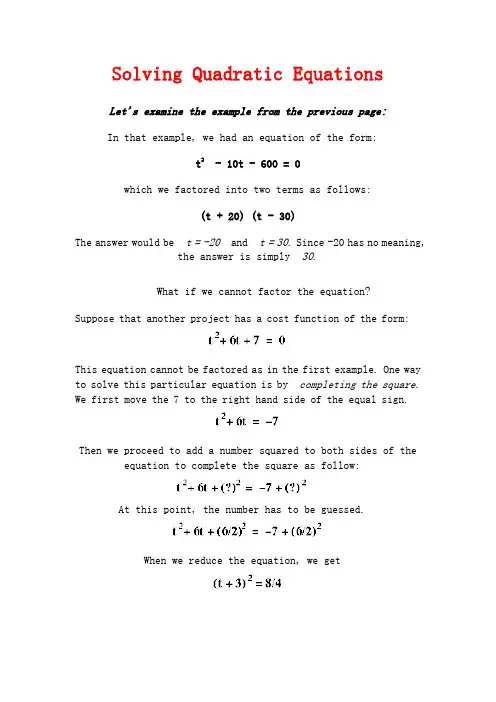
Solving Quadratic EquationsLet's examine the example from the previous page:In that example, we had an equation of the form:t2 - 10t - 600 = 0which we factored into two terms as follows:(t + 20) (t - 30)The answer would be t = -20 and t = 30. Since -20 has no meaning,the answer is simply 30.What if we cannot factor the equation?Suppose that another project has a cost function of the form:This equation cannot be factored as in the first example. One way to solve this particular equation is by completing the square. We first move the 7 to the right hand side of the equal sign.Then we proceed to add a number squared to both sides of the equation to complete the square as follow:At this point, the number has to be guessed.When we reduce the equation, we getThe equation yields two answersIf we cannot factor the equation, we can still solve it by the method of completing the square as shown in the above example.A few simple facts that you should knowDid you know that there are other methods for solving a quadratic equation, such as factoring, completing the square, or using the quadratic formula?How do I know which method to use?∙Use factoring when the equation is simple and the factors are obvious. Use completing the square when you cannotfactor the equation. When in doubt, use the QuadraticFormula, shown on the next page, which works for anyquadratic equations.What is actually meant by solving a quadratic equation?∙Solving a quadratic equation means finding the values of x where the graph cuts the x-axis.Do you know how the graph for a quadratic equation look? The graph for a quadratic equation is a parabola.∙If the parabola cuts the x-axis at only one point it means that the quadratic equation has two solutions with the same value (the value of x where the parabola touches thex-axis).∙If the parabola cuts the x-axis at two points it means that it has two solutions (the points where the parabola crosses the x-axis).∙If the parabola doesn't cut the x-axis it means that the quadratic equation doesn't have any real solution.Try to find the solutions of x2 + 1 , x2 + 2x + 1 , x2 - 1 by using the Graphing workbench .。
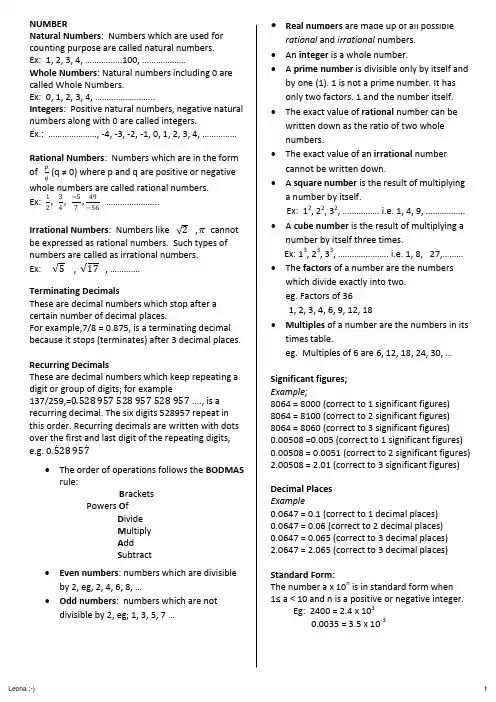
2024年上海市英语初三上学期期末复习试题及答案指导一、听力部分(本大题有20小题,每小题1分,共20分)1、Listen to the following dialogue and answer the question. (1.5 points)A. In a library.B. At a bus stop.C. At a restaurant.D. In a hotel.Answer: B. At a bus stop.Explanation: The dialogue mentions the person has to get on the bus and that there are no more tickets available, indicating they are at a bus stop.2、 Listen to the passage and answer the question. (1.5 points)A. It is a very old book.B. It is written in English.C. It is about a famous writer.D. It was written in the 19th century.Answer: B. It is written in English.Explanation: The passage clearly states that the book is written in English, which helps to identify the correct answer.3、Question: What are the twins doing right now?A. They are reading books in the library.B. They are watching a movie at home.C. They are playing soccer in the park.Answer: CExplanation: The twins are often seen playing sports, and the context implies they are engaged in an outdoor activity. Therefore, the correct answer is that they are playing soccer in the park.4、Question: How do the students feel about their teacher after the school trip?A. They are sad because the teacher is too strict.B. They are happy because the teacher is very friendly.C. They are confused because the teacher is not clear about the trip rules.Answer: BExplanation: The conversation before the question mentions how the teacher made the trip fun for everyone and involved the students actively. This suggests a positive experience, making the best answer that the students are happy because the teacher is very friendly.5.You hear a conversation between two students, John and Sarah, discussing their summer plans.John: “Hey Sarah, have you decided what you’re going to do for your summer vacation?”Sarah: “Well, I’m planning to go on a trip to the beach. How about you?”Question: What is Sarah’s summer plan?A) Go on a beach tripB) Visit her grandparentsC) Study abroadD) Work part-timeAnswer: A) Go on a beach tripExplanation: Sarah directly states her plan to go on a trip to the beach, which makes option A the correct answer.6.You hear a news report about a local charity event that took place last weekend.Reporter: “Last weekend, the local community center hosted a charity event to raise funds for the children’s hospital. Many local businesses and individuals donated money and time. The event included a bake sale, a silent auction, and a talent show. According to the organizers, the event was a great success and they were able to raise over$5,000 for the hospital.”Question: What did the charity event raise money for?A) A local schoolB) The children’s hospitalC) A local shelterD) An animal sanctuaryAnswer: B) The children’s hospit alExplanation: The news report explicitly mentions that the charity event was for the children’s hospital, making option B the correct answer.7、 According to the weather forecast, the temperature will significantly drop tomorrow.•Answer: C•Explanation: The correct answer is C, as the forecast mentions the temperature will significantly drop. The other options do not accurately reflect what the forecast states.8、The speaker suggests that students should start studying from now on to prepare for the exam.•Answer: B•Explanation: The correct answer is B because the speaker advises students to begin their studies promptly to ensure good preparation for theupcoming exam. The other options do not align with the advice given in the recording.9.You are listening to a conversation between two students, Anna and Bob, discussing their vacation plans.Anna: Hi Bob, I’m thinking of going to Greece for my vacation. Have you considered anywhere else?Bob: (Answer)A) I thought about Portugal but isn’t it a bit too hot in the summer?B) Yeah, Greece sounds great. Maybe the Amalfi Coast could be an interesting alternative.C) Personally, I’m looking into visiting Japan, but I’m unsure if it’s too far.Answer: B) Yeah, Greece sounds great. Maybe the Amalfi Coast could be an interesting alternative.解析: Bob回复说“Greece sounds great. Maybe the Amalfi Coast could be an interesting alternative.”,这表明他认为希腊听起来很好,可能还会考虑意大利的阿马尔菲海岸作为另一个选择。
2.4 Solving Quadratic Equations Using the QuadraticFormulaFor use with Exploration 2.4Essential Question How can you derive a formula that can be used towrite the solutions of any quadratic equation in standard form?Work with a partner. The following steps show a method of solving 20.ax bx c ++= Explain what was done in each step.()22222222222220 1. 4440 2. _____________________________444 3. _____________________________444 4. _____________________________24 5.ax bx c a x abx ac a x abx ac b b a x abx b b ac ax b b ac++=++=+++=++=−+=−Write the equation._____________________________2 6. _____________________________27. _____________________________8. _____________________________ax b ax b x +==−±=:Quadratic Formula1 EXPLORATION: Deriving the Quadratic Formula2.4Solving Quadratic Equations Using the Quadratic Formula (continued)Work with a partner.a. Solve 20ax bx c ++= by completing the square. (Hint: Subtract c from each side, divide each side by a , and then proceed by completing the square.)b. Compare this method with the method in Exploration 1. Explain why you think 4a and 2b were chosen in Steps 2 and 3 of Exploration 1.Communicate Your Answer3. How can you derive a formula that can be used to write the solutions of anyquadratic equation in standard form?4. Use the Quadratic Formula to solve each quadratic equation.a. 2230x x +−=b. 2440x x −+=c. 2450x x ++=5. Use the Internet to research imaginary numbers . How are they related to quadraticequations?2 EXPLORATION: Deriving the Quadratic Formula by Completing the Square2.4 For use after Lesson 2.4Core ConceptsQuadratic FormulaThe real solutions of the quadratic equation 20++=ax bx c are42b x a−±=Quadratic Formulawhere 0≠a and 240.−≥b acNotes:Interpreting the Discriminant240b ac −> 240b ac −= 240b ac −<• two real solutions • one real solution • no real solutions• two x -intercepts • one x -intercept • no x -intercepts Notes:Practice2.4 Notes:(continued)Practice Methods for Solving Quadratic EquationsMethodAdvantages DisadvantagesFactoring(Lessons 2.5–2.8) • Straightforward when the equation can be factored easily• Some equations are notfactorable. Graphing (Lesson 4.2)• Can easily see the number of solutions • Use when approximate solutions aresufficient.• Can use a graphing calculator • May not give exact solutionsUsing Square Roots (Lesson 4.3)• Used to solve equations of the form 2.x d =• Can only be used for certain equations Completing the Square (Lesson 4.4) • Best used when 1=a and b is even• May involve difficult calculationsQuadratic Formula (Lesson 4.5)• Can be used for any quadratic equation • Gives exact solutions• Takes time to docalculations Worked-Out Examples Example #1Solve the equation using the Quadratic Formula. Round your solutions to the nearest tenth, if necessary.6x 2 − 13x = −66x 2 − 13x + 6 = −6 + 66x 2 − 13x + 6 = 0x =−b ± √—b 2 − 4ac —— 2a=−(−13) ± √——(−13)2 − 4(6)(6) ——— 2(6)=13 ± √—169 − 144 —— 12=13 ± √—25 — 12 =13 ± 5— 12The solutions are x =13 + 5 —12=18 —12=3—2and x =13 − 5 — 12=8 — 12=2 —3.2.4 7. A square pool has a side length of x feet. A uniform border around the pool is 1 foot wide. The total area of the pool and the border is 361 square feet. What is the area of the pool?In Exercises 8–10, determine the number of real solutions of the equation.8. 2630x x −++= 9. 2690x x ++= 10. 2380x x ++=In Exercises 11–13 find the number of x -intercepts of the graph of the function.11. 243y x x =−++ 12. 21449y x x =++ 13. 2818y x x =−−−In Exercises 14–16, solve the equation using any method. Explain your choice of method.14. 24416x x −+=15. 2870x x −+=16. 2350x x +−=(continued)Practice In Exercises 1–6, solve the equation using the Quadratic Formula. Round your solutions to the nearest tenth, if necessary.1. 210160x x −+=2. 2280x x +−=3. 2320x x −−=4. 2613x x +=− 5. 23517x x −+−=− 6. 248126x x −++=Example #2Solve the equation using the Quadratic Formula. Round your solutions 2x 2 + 9x + 7 = 32x 2 + 9x + 7 − 3 = 3 − 32x 2 + 4x + 4 = 0to the nearest tenth, if necessary.=−9 ±√—49 — 4 =−9 ± 7— 4=−9 − 7 — 4=−16 — 4= −4.x =−b ± √—b 2 − 4ac —— 2a=−9 ± √——92 − 4(2)(4) ——2(2)=−9 ± √—81 − 32—— 4Practice AIn Exercises 1–3, write the equation in standard form. Then identify the values of a , b , and c that you would use to solve the equation using the Quadratic Formula.1. 229x x +=2. 2617x x −=3. 210249x x −+=−+In Exercises 4–11, solve the equation using the Quadratic Formula. Round your solutions to the nearest tenth, if necessary.4. 28160x x −+=5. 210110x x +−=6. 22730x x −+=7. 25310x x +−=8. 25340x x −+=9. 221x x =−− 10. 2893x x +=11. 2524x x −+=12. You launch a water balloon. The function 20.08 1.62h t t =−++ modelsthe height h (in feet) of the water balloon after t seconds. a. After how many seconds is the water balloon at a height of 9 feet?b. After how many seconds does the water balloon hit the ground?In Exercises 13–15, determine the number of real solutions of the equation.13. 2438x x =−− 14. 22470x x −−+= 15. 2690x x ++=In Exercises 16–18, find the number of x -intercepts of the graph of the function.16. 2363y x x =−+ 17. 2439y x x =++ 18. 2231y x x =−−+In Exercise 19–24, solve the equation using any method. Explain your choice of method.19. 22013x x −= 20. 2721x x −= 21. 2972x −= 22. 27789x x +=− 23. 25410x x =+24. 212360x x −+=25. Consider the equation 23560.x x ++= a. Use the discriminant to determine the number of solutions. b. Change the sign of c in the equation. Write the new equation.c. Use the discriminant to determine the number of solutions of the new equation.Did your answer change? Explain.。
trival和trivial的用法Trivial 和Trivial 的用法Trivial 和trivial 是两个拼写相似但含义截然不同的形容词。
尽管拼写很相似,但这两个词的用法却有着明显的区别。
在本文中,我们将全面探讨这两个词的定义、用法以及如何在不同上下文中正确使用它们。
一、定义与词源Trivial 这个词源于拉丁语"trivialis",意为"来自公共场所" 或"最常见的"。
它最早的含义是"与公共事务或一般事物有关的",后来才演变成"不重要的" 或"琐碎的"。
而trivial 这个词则源于更为古老的拉丁语"trivium",是"三类" 或"三个交叉点" 的意思。
后来,这个词的意义扩展为"初级知识" 或"基础",而其形容词形式trivial 则用来描述那些"简单的"、"普通的"或"显而易见的" 事物。
两个词的起源虽然相似,但随着时间推移,它们在英语中的用法和含义逐渐有了分化。
下面我们将分别详细介绍这两个形容词的用法。
二、Trivial 的用法Trivial 一词在当代英语中的用法多指"不重要的"、"琐碎的" 或"微不足道的"。
它经常用来形容那些无关紧要的或无意义的事物,如琐细的细节、琐碎的问题或平凡的事件。
以下是一些常见的用法示例:1. "She is always concerned about trivial matters and often overlooks the bigger picture."(她总是关心琐碎的事情,经常忽视整体大局。
方程的英语知识点总结Key Concepts of Equations:1. Definition of an Equation: An equation is a mathematical statement that asserts the equality of two expressions, typically denoted as LHS = RHS, where LHS (left-hand side) and RHS (right-hand side) are mathematical expressions containing variables and constants.2. Variables and Constants: In an equation, variables are symbols that represent unknown quantities, while constants are fixed numerical values. Equations allow us to solve for the value of the variable by manipulating the given information and applying various mathematical operations.3. Solutions of an Equation: The solution of an equation is the value or set of values for the variable that make the equation true. A solution to an equation satisfies the equality relationship between the LHS and RHS.4. Solving Equations: The process of finding the solutions to an equation involves using algebraic techniques to manipulate the given expressions and isolate the variable. Common methods for solving equations include combining like terms, applying inverse operations, and factoring.5. Equivalent Equations: Two equations are said to be equivalent if they have the same solution set. Algebraic manipulations such as adding or subtracting the same quantity from both sides, multiplying or dividing both sides by the same non-zero number, and applying the properties of exponents can be used to derive equivalent equations.6. Applications of Equations: Equations are used to model various real-world scenarios, such as calculating the trajectory of a projectile, determining the growth of populations, analyzing the behavior of electrical circuits, and predicting the spread of infectious diseases. Types of Equations:1. Linear Equations: A linear equation is an equation of the form ax + b = c, where x is the variable, a and b are constants, and c is a constant term. The graph of a linear equation is a straight line, and the solutions to a linear equation form a single point, a line, or no points (in the case of parallel lines).2. Quadratic Equations: A quadratic equation is an equation of the form ax^2 + bx + c = 0, where x is the variable, and a, b, and c are constants with a ≠ 0. Quadratic equations have solutions that can be found using the quadratic formula, factoring, or completing the square. The graph of a quadratic equation is a parabola.3. Exponential Equations: An exponential equation is an equation in which the unknown variable appears as an exponent. Exponential equations arise in situations involving exponential growth or decay, such as population growth, radioactive decay, and compound interest problems.4. Trigonometric Equations: Trigonometric equations involve trigonometric functions such as sine, cosine, and tangent. These equations often arise in problems related to periodic phenomena, wave functions, and harmonic motion.Properties of Equations:1. Reflexive Property: For any real number a, a = a.2. Symmetric Property: If a = b, then b = a.3. Transitive Property: If a = b and b = c, then a = c.4. Addition Property of Equality: If a = b, then a + c = b + c.5. Subtraction Property of Equality: If a = b, then a - c = b - c.6. Multiplication Property of Equality: If a = b, then ac = bc.7. Division Property of Equality: If a = b and c ≠ 0, then a/c = b/c.8. Multiplicative Property of Zero: For any real number a, a × 0 = 0.9. Multiplicative Property of One: For any real number a, a × 1 = a.10. Distributive Property: For any real numbers a, b, and c, a(b + c) = ab + ac.In conclusion, equations are a vital aspect of mathematics and are used to express and solve a wide range of problems in various fields. Understanding the key concepts, types, and properties of equations is essential for mastering algebra and applying mathematical principles to real-world situations. By studying equations and their properties, one can develop problem-solving skills and analytical thinking, which are invaluable in academic, professional, and everyday life.。